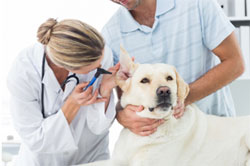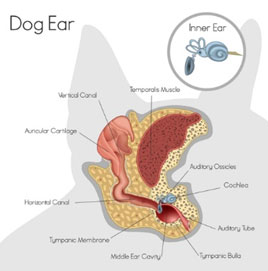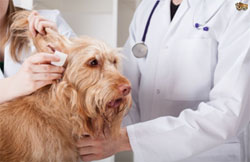Written by Dr Helen Burns
Dog and cat owners often ask vets about caring for their pet’s ears. The truth of the matter is that normal healthy ears are remarkably self sufficient. They are designed with their own self cleaning mechanism. It is only when this fails that we need to intervene.
How do ears stay clean naturally?
Our pets’ ears are lined with skin that is similar to that on their ear flap.  This skin contains glands that secrete waxy and oily material that combines with shed skin cells to form what we know as ear wax. Remarkably, for something that seems so simple, ear wax plays two very important roles.
This skin contains glands that secrete waxy and oily material that combines with shed skin cells to form what we know as ear wax. Remarkably, for something that seems so simple, ear wax plays two very important roles.
Firstly, it keeps the ear drum soft and moist. Have you ever wondered what happens to all that dirt in your pet’s ears after it rolls around on the ground? Well, ear wax traps foreign material that gets into the ears, such as dust and dirt, then the skin cells lining the ear move the wax up and out of the ear like a conveyor belt. Thanks to this process, ear wax doesn’t build up in normal healthy ears.
Why do dog’s ears get infected?
Approximately 20% of dogs and 4% of cats will get an ear infection at some stage in their life, and many dogs will have recurrent bouts of what we term otitis externa, or an external ear infection.  Ear infections can have many causes, though commonly moisture and an allergy or irritant are involved. Shampoo or water in the ear after a bath or swim is a common culprit.
Ear infections can have many causes, though commonly moisture and an allergy or irritant are involved. Shampoo or water in the ear after a bath or swim is a common culprit.
It doesn’t matter if the water is clean or dirty, it’s just that fact that it’s wet! Likewise, humidity in Spring and Summer can be enough to push sensitive dogs’ ears over the edge.
Many dogs who get ear infections have an underlying allergy, and ear infections may be the first clue. If your pet seems to get ear infections repeatedly, then it’s well worth investigating for an underlying allergy such as atopy or a food allergy.
How to tell if your dog or cat has an ear infection?
Dogs and cats are remarkably tough creatures and may not give you any obvious signs that they have an infected ear. For this reason, it’s important to regularly look at, and dare I say, smell your pet’s ears.
Infected ears will often have a strong odour, there may be a discharge in the ear canal, and you may notice that their ear flap or ear canal may be red.
Some dogs will shake their head, paw at their ear, hold their head to the side, or groan or cry when their ear is touched. These are clear signs that your dog needs to see their vet for a thorough check up and ear swab.
What can be done to treat an ear infection?
Once an ear infection starts, with an allergy or moisture, the cells lining the ear produce more and more waxy discharge. This can plug up the ear canal and create a perfect little incubator for the bugs trapped inside, which flourish.
 Once your pet’s ear has been checked by your vet, and a swab has been examined under a microscope, the culprit will be identified, usually yeast and/or bacteria. At this stage it is ideal to give the ear a clean, to remove the plugged wax and clear the canal to give the ear drops a fighting chance.
Once your pet’s ear has been checked by your vet, and a swab has been examined under a microscope, the culprit will be identified, usually yeast and/or bacteria. At this stage it is ideal to give the ear a clean, to remove the plugged wax and clear the canal to give the ear drops a fighting chance.
Next up are the ear drops. I recommend a gentle rub near the ear, then apply the ear drops into the canal, followed by a special treat so they know that they have been brave! Ensure to finish the course so that the infection is totally cleared.
Ear care
What we really need to do to keep your pet’s ears happy and healthy is to enable them to do their job properly! If moisture is a factor in their ear infections, then it may be wise to try to keep their ears dry when having a bath, only washing from the collar towards the tail and using a facecloth for their face.
Swimming is a tricky one. So many dogs live for their swimming in Summer, and we don’t want to spoil their fun, so ensuring that their ears are dried after a swim may help. For most dogs, plucking the hair out of their ears is unnecessary, in fact nature seems to know best again, because the hair can help to keep moisture and debris out of the ear canal.
Author Bio: Dr HELEN BURNS BVSc (Hons)
 Helen graduated from Sydney University in 1997 with First Class Honours and worked in a practice on the Northern Beaches for 16 years. Helen joined the Gordon Vet on the Upper North Shore early in 2014 and our clients have really enjoyed getting to know her. She loves being a vet and takes a keen interest in all of her patients. Her gentle, friendly nature helps pets to feel relaxed when they visit the vet.
Helen graduated from Sydney University in 1997 with First Class Honours and worked in a practice on the Northern Beaches for 16 years. Helen joined the Gordon Vet on the Upper North Shore early in 2014 and our clients have really enjoyed getting to know her. She loves being a vet and takes a keen interest in all of her patients. Her gentle, friendly nature helps pets to feel relaxed when they visit the vet.